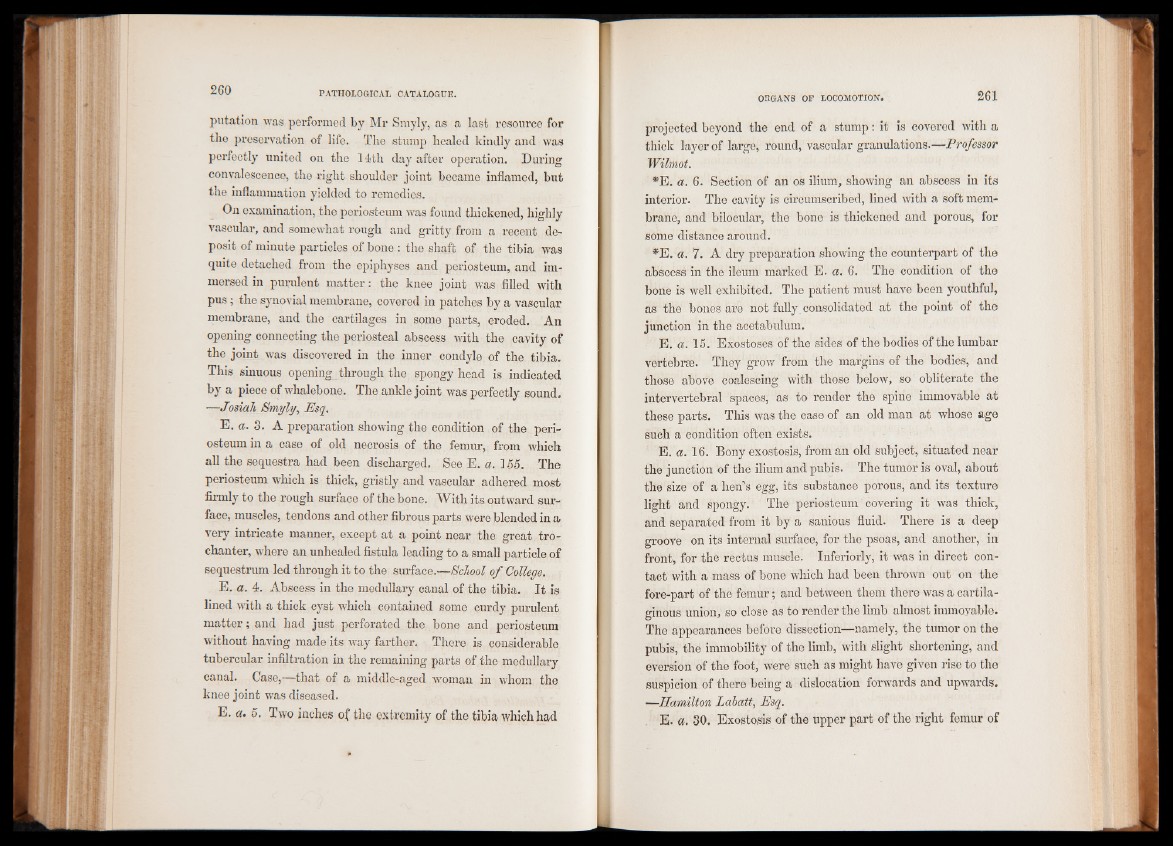
putation was performed by Mr Smyly, as a last resource for
the preservation of life. The stump healed kindly and was
perfectly united on the 14th day after operation. During
convalescence, the right shoulder joint became inflamed, but
the inflammation yielded to remedies.
On examination, the periosteum was found thickened, highly
vascular, and somewhat rough and gritty from a recent deposit
of minute particles of bone : the shaft of the tibia was
quite detached from the epiphyses and periosteum, and immersed
in purulent matter: the knee joint was filled with
pus; the synovial membrane, covered in patches by a vascular
membrane, and the cartilages in some parts, eroded. An
opening connecting the periosteal abscess with the cavity of
the joint was discovered in the inner condyle of the tibia.
This sinuous opening through the spongy head is indicated
by a piece of whalebone. The ankle joint was perfectly sound.
—Josiah Smyly, Esq.
E. a. 3. A preparation showing the condition of the periosteum
in a case of old necrosis of the femur, from which
all the sequestra had been discharged. See E. a. 155. The
periosteum which is thick, gristly and vascular adhered most
firmly to the rough surface of the bone. With its outward surface,
muscles, tendons and other fibrous parts were blended in a
very intricate manner, except at a point near the great trochanter,
where an unhealed fistula leading to a small particle of
sequestrum led through it to the surface.—School of College.
E. a. 4. Abscess in the medullary canal of the tibia. It is
lined with a thick cyst which contained some curdy purulent
matter; and had just perforated the bone and periosteum
without having made its way farther. There is considerable
tubercular infiltration in the remaining parts of the medullary
canal. Case,—that of a middle-aged woman in whom the
knee joint was diseased.
E. a. 5. Two inches of the extremity of the tibia which had
projected beyond the end of a stump: it is covered with a
thick layer of large, round, vascular granulations.—Professor
Wilmot.
*E. a. 6. Section of an os ilium, showing an abscess in its
interior. The cavity is circumscribed, lined with a soft membrane,
and bilocular, the bone is thickened and porous, for
some distance around.
*E. a. 7. A dry preparation showing the counterpart of the
abscess in the ileum marked E. a. 6. The condition of the
bone is well exhibited. The patient must have been youthful,
as the bones are not fully consolidated at the point of the
junction in the acetabulum.
E. a. 15. Exostoses of the sides of the bodies of the lumbar
vertebrae. They grow from the margins of the bodies, and
those above coalescing with those below, so obliterate the
intervertebral spaces, as to render the spine immovable at
these parts. This was the case of an old man at whose age
such a condition often exists.
E. a. 16. Bony exostosis, from an old subject, situated near
the junction of the ilium and pubis. The tumor is oval, about
the size of a hen’s egg, its substance porous, and its texture
light and spongy. The periosteum covering it was thick,
and separated from it by a sanious fluid. There is a deep
groove on its internal surface, for the psoas, and another, in
front, for the rectus muscle. Inferiorly, it was in direct contact
with a mass of bone which had been thrown out on the
fore-part of the femur; and between them there was a cartilaginous
union, so close as to render the limb almost immovable.
The appearances before dissection—namely, the tumor on the
pubis, the immobility of the limb, with slight shortening, and
eversion of the foot, were such as might have given rise to the
suspicion of there being a dislocation forwards and upwards.
—Hamilton Labatt, Esq.
E. a. 30. Exostosis of the upper part of the right femur of